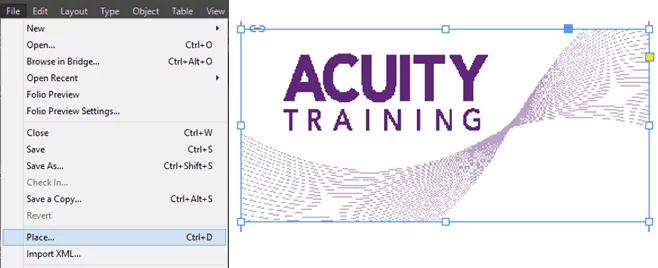
The Complete Guide To Master Pages In InDesign
Master pages are a huge time saver in InDesign.
They’re a great ‘one and done’ solution to make sure that all of your content is consistently formatted.
If you are an InDesign beginner, learning to use master pages should be a priority.
In this tutorial, you’ll learn
-
-
-
- What Are Master Pages In InDesign?
- Why Are Master Pages Used?
- What Is A-Master In InDesign?
- A Simple Example Of A Master Page
- How Do I Create A Master Page In InDesign ?
- How Do I Apply A Master Page To My Document?
- How Do I Unlink Pages From Master Pages?
- Can I Reuse A Master Page In Other Projects?
- 2 Common Mistakes People Make With Master Pages
- Final Thoughts
-
-
What Are Master Pages In InDesign?
A master page is a page template. It holds and transmits throughout your document details of how you want all of the elements on each page to appear.
This applies to
- Headers
- Footers
- Logos
- Position of page numbers
- Position of body text
- Page size
- Background that repeats
- Margins and more.
Master pages have the advantage that all elements you place will stay the same and your document will have a consistent appearance. In other words, the position of text, margin settings, bullet points, type of buttons, headers, and footers will remain the same throughout the document.
Why Are Master Pages Used In InDesign?
Master pages ensure that your document is presented consistently throughout.
A single-page document does not require master pages.
Master pages become valuable when you are creating a multi-page document, like a brochure, or book. They let you replicate the design elements that you want consistently on each page.
They become even more valuable when you are creating a series of documents that need to be presented consistently.
They allow you to set up a master page in one document and copy the formatting from your original document to the other documents in the series.
What Is A-Master In InDesign?
A-Master is a pre-set master page that appears automatically when a new document is created in InDesign.
InDesign names master pages alphabetically using letters are prefixes.
This means that the first master page you create will be named B-Master. The next one will be called C- master and so on.
You are allowed to create as many Master pages as you want.
A Simple Example Of A Master Page
The image below shows that a green square, after being created on the A-Master page, has been transferred to all left pages in the document automatically.
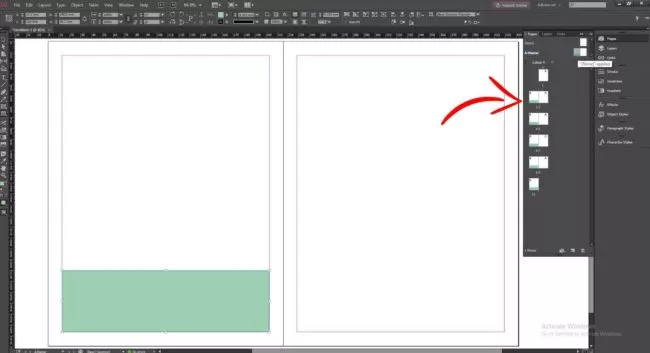
If you wanted to apply to a green square on both sides of the spread, you would simply copy the square onto the opposite page as well.
How Do I Create A Master Page In InDesign ?
When you create a new document InDesign automatically creates a master page for you. It is called A-Master as discussed above.
If you would like to check this go to Window > Pages, or hit F12.
You’ll see the A-Master page, if your document is a single page or a spread A-Master for double-facing documents.
You’ll notice that all the pages have the letter “A” on them. This means that they’re linked to the A-Master.
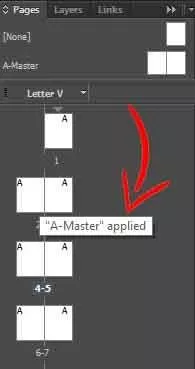
There are two way to add more master pages. You can create them from scratch or modify an existing Master page.
Creating A Master Page from Scratch
Step 1. In the Pages panel, click the Window menu, then click Pages.
Step 2. Right-click on the exiting Master page. When the Options window pops up, click on New Master.
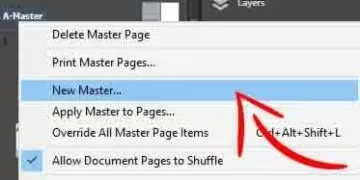
Step 3. Choose Your Preferences.
-
- Prefix. You can enter a prefix up to four characters, or simply leave the suggested one. Prefix B will be suggested if it’s your first additional master page. Later on, they appear sequentially in alphabetical order.
- Name. Enter a name for the master page. Also, you can leave their suggestion.
- Based on Master. You can select an existing master if you want your new Master to be similar to other you created. Or select None, if you wish a brand-new Master template.
- Number of Pages. You can include up to ten pages (1-10) in the master spread.
Click OK.
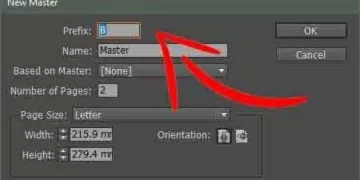
Creating A Master Page From An Existing Page
Step 1. Go to the Pages panel. You can select a page or spread (by holding shift and alt), then drag a page or a spread from the document page area to the master page area.
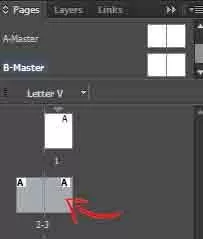
You’ll see that A-Master has been applied to the new C-Master page.
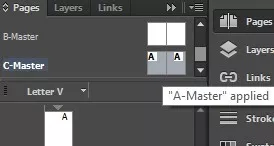
Another way to do it, is to select a page or spread, point to a Master Page ( A-Master, B-Master etc.), and then click New Master.
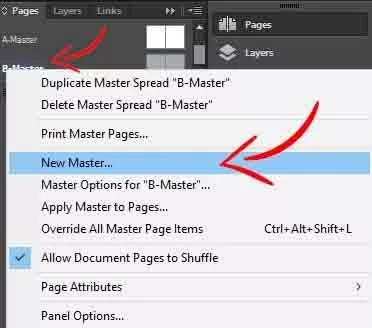
Click Based on Master and select Master of your choice.
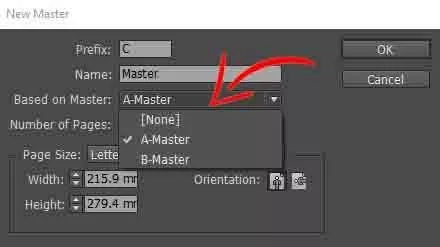
How Do I Apply A Master Page To My Document?
It is very simple to apply a master page to a document once one has been created.
Applying A Different Master Page To A Single Page
Step 1. Go to Pages Panel, then drag the Master page icon to the page icon of the page you wish the Master page to be applied. Wait until the black frame surrounds the page before releasing the mouse.
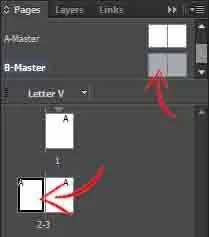
After releasing the mouse, you’ll see that your B-Master page has been applied.
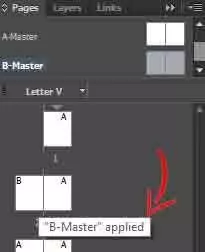
Applying A Different Master Page To Several Pages
Step 1. Go to Layout > Pages, then select Apply Master to Pages.
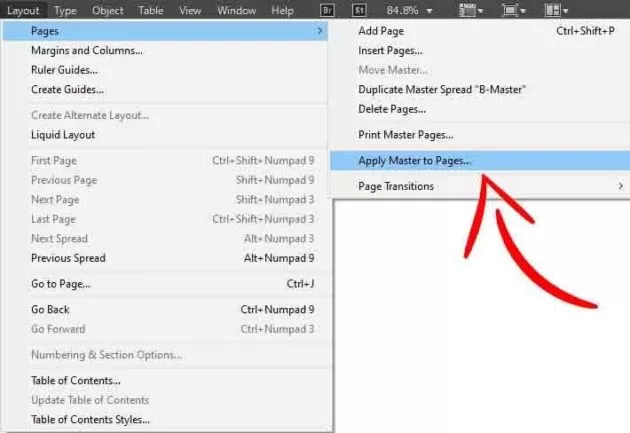
Step 2. Select All pages, if you wish your Master page to be applied on all of them,
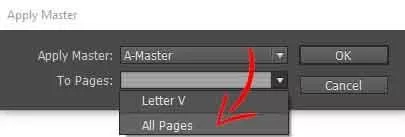
or just type in the page range you want, for instance from 2-10.

How Do I Unlink Pages From Master Pages?
Unlinking a page from an InDesign master is very simple.
Go to the Pages window. Click and drag None from the list of master pages onto the pages you want unlinked from their Master pages.
Alternatively, select the pages you want to change from the Pages window, then right-click, and select Apply Master to Pages.
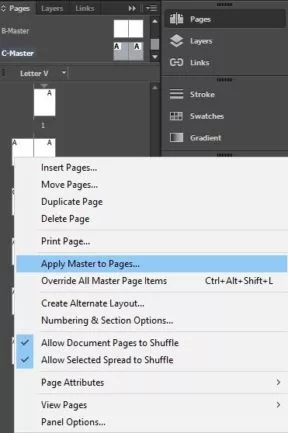
You then select the [None] master from the listing.
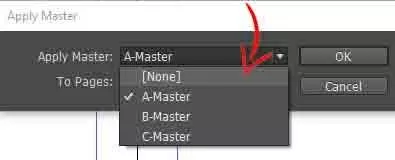
Can I Reuse A Master Page In Other Projects?
Yes, you can reuse a master page on multiple projects.
InDesign allows you to save master pages so that they can be shared and reused multiple times. InDesign templates are also available online and can be downloaded.
Step 1. Go to Pages window and open the top-right menu. Select Master Pages and then Load Master Pages.
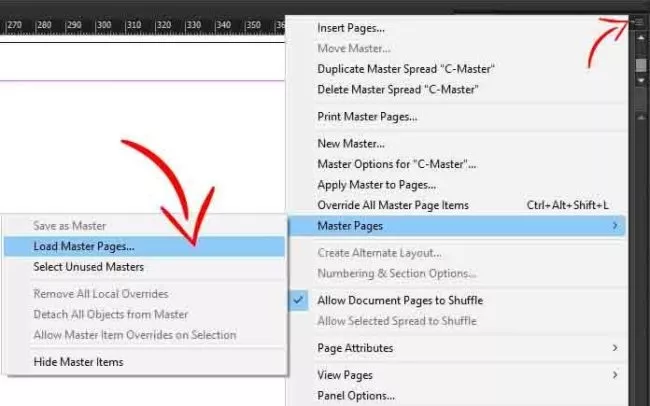
Step 2. Now, choose the document that contains the Master Pages you want to upload. If there’s a conflict appearing, you’ll be asked to rename the document.
It is worth noting that automatic page numbering uses master pages in InDesign.
2 Mistakes People Make with Master Pages
MISTAKE #1: What if elements on a master pages are not showing up ?
This is usually caused by an issue with your layers.
The first step is to verify that each element on your master page is in the right order.
If that’s not the cause, check if the items on the master page are on a hidden layer?
To check this. Go to the Master, select the object that is missing and open the Layers panel. Make sure the eyeball icon is visible on the left next to the layer to be sure that the layer is not hidden.
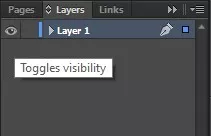
MISTAKE #2: Master pages are not showing up?
If you are having issues with your master pages disappearing your files may have been corrupted.
The fix is to export your files to an IDML file and then save them. This usually fixes the issue.
Step 1. Export your document to an IDML file – File> Export.
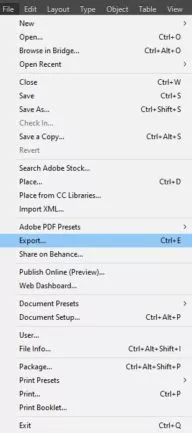

Step 2. Rename your document and make sure to save the IDML file to the same folder as the INDD, so all the links remain.
Try your master pages now. This usually fixes the issue.
Conclusion
Learning to use master pages is a huge time saver, along with using spell check to check your documents.
Professional designers have libraries of master pages that they’ve previously created.
Next time you create a page layout you are pleased with make sure that you save it for future.
Other InDesign Tutorials
Why Are My Images Fuzzy And Low Res In InDesign?
How To Use Page Numbering In InDesign
How To Use Master Pages In InDesign
Working With Tables In InDesign


